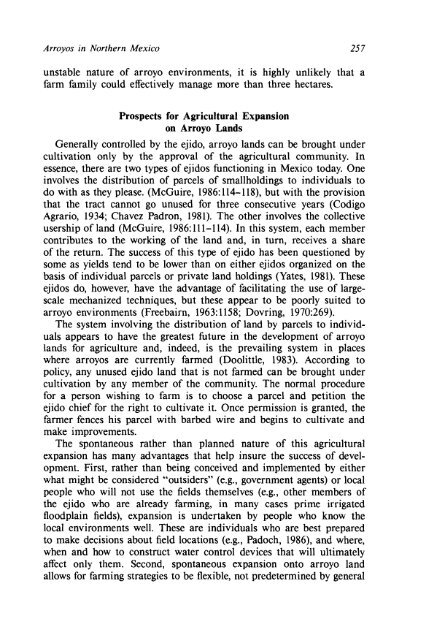Fragile Lands of Latin America Strategies for ... - PART - USAID
Fragile Lands of Latin America Strategies for ... - PART - USAID
Fragile Lands of Latin America Strategies for ... - PART - USAID
Create successful ePaper yourself
Turn your PDF publications into a flip-book with our unique Google optimized e-Paper software.
Arroyos in Northern Mexico 25 7<br />
unstable nature <strong>of</strong> arroyo environments, it is highly unlikely that a<br />
farm family could effectively manage more than three hectares.<br />
Prospects <strong>for</strong> Agricultural Expansion<br />
on Arroyo <strong>Lands</strong><br />
Generally controlled by the ejido, arroyo lands can be brought under<br />
cultivation only by the approval <strong>of</strong> the agricultural community. In<br />
essence, there are two types <strong>of</strong> ejidos functioning in Mexico today. One<br />
involves the distribution <strong>of</strong> parcels <strong>of</strong> smallholdings to individuals to<br />
do with as they please. (McGuire, 1986: 114-1 18), but with the provision<br />
that the tract cannot go unused <strong>for</strong> three consecutive years (Codigo<br />
Agrario, 1934; Chavez Padron, 198 1). The other involves the collective<br />
usership <strong>of</strong> land (McGuire, 1986: 11 1-1 14). In this system, each member<br />
contributes to the working <strong>of</strong> the land and, in turn, receives a share<br />
<strong>of</strong> the return. The success <strong>of</strong> this type <strong>of</strong> ejido has been questioned by<br />
some as yields tend to be lower than on either ejidos organized on the<br />
basis <strong>of</strong> individual parcels or private land holdings (Yates, 1981). These<br />
ejidos do, however, have the advantage <strong>of</strong> facilitating the use <strong>of</strong> large-<br />
scale mechanized techniques, but these appear to be poorly suited to<br />
arroyo environments (Freebairn, 1963: 11 58; Dovring, 1970:269).<br />
The system involving the distribution <strong>of</strong> land by parcels to individ-<br />
uals appears to have the greatest future in the development <strong>of</strong> arroyo<br />
lands <strong>for</strong> agriculture and, indeed, is the prevailing system in places<br />
where arroyos are currently farmed (Doolittle, 1983). According to<br />
policy, any unused ejido land that is not farmed can be brought under<br />
cultivation by any member <strong>of</strong> the community. The normal procedure<br />
<strong>for</strong> a person wishing to farm is to choose a parcel and petition the<br />
ejido chief <strong>for</strong> the right to cultivate it. Once permission is granted, the<br />
farmer fences his parcel with barbed wire and begins to cultivate and<br />
make improvements.<br />
The spontaneous rather than planned nature <strong>of</strong> this agricultural<br />
expansion has many advantages that help insure the success <strong>of</strong> devel-<br />
opment. First, rather than being conceived and implemented by either<br />
what might be considered "outsiders" (e.g., government agents) or local<br />
people who will not use the fields themselves (e.g., other members <strong>of</strong><br />
the ejido who are already farming, in many cases prime irrigated<br />
floodplain fields), expansion is undertaken by people who know the<br />
local environments well. These are individuals who are best prepared<br />
to make decisions about field locations (e.g., Padoch, 1986), and where,<br />
when and how to construct water control devices that will ultimately<br />
affect only them. Second, spontaneous expansion onto arroyo land<br />
allows <strong>for</strong> farming strategies to be flexible, not predetermined by general

















